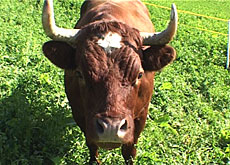
Evolèner cows return to the pasture

Like many breeders of endangered cattle, Gotti Fankhauser cannot live from farming alone - his day job is as a caretaker for the post office.
But that hasn’t stopped him from spending all his spare time rearing ten rare Evolène cattle.
“The farm here – especially with these animals – is my calling. If I had to choose between making a living out of a farm or doing my normal job, it would be an easy choice,” he says.
His eight cows are free to roam across 4.5 hectares of prime grazing pasture in Rüschegg Gambach, canton Bern. The eight-month-old bull – a lively bovine – and a small bull calf share the barn for the moment.
Heidi and Peter would have been at home here, 900 metres above sea level. The pastures are so intensely green that it almost hurts the eyes to look at them.
Introducing the girls
On a brisk autumn day, Gotti proudly introduced me to each member of his herd in turn. Unabashed, the females came close enough to sniff me, experimentally licking my coat and jeans with their large pink tongues.
They are beautiful, dainty, easy-going creatures with big personalities and small horns. They clearly enjoy fighting with each other, but are very trusting towards humans.
The Evolènes’ coats tend to be a dark amber, with white spots on their stomachs, tails and often over their backs and foreheads. Sometimes they are black, flecked with white patches.
Facing Extinction
These white markings nearly caused their demise, when the canton of Valais, from which they originate, decided at the end of the 19th century to focus breeding efforts on producing entirely brown cows. As the Evolène faded from the scene, the Eringer became ever more popular.
By the beginning of the 1990s, and just before the breed became extinct, the herd began to expand again. In upper Valais, new breeders acquired Evolène cows for their tasty meat, and good milk.
They produce large quantities of milk in relation to their body size. They were recognised as robust and less likely to catch infections than common breeds, as well as being extremely strong and well suited to wild summer grazing pastures up to 2,000 metres.
North of the Lötschberg tunnel, breeders started to add Evolènes to their existing herds, amid loud protest from the Valais farmers, who felt the cattle should be confined to their home canton.
With the help of the Swiss Environmental Foundation, Pro Specie Rara, the breeders on both sides of the country set up associations, and started herd books. Gotti Fankhauser is President of the northern Swiss association.
Preventing inbreeding
Breeders have to consult the herd book when they buy in new cattle. The book has genetic details of all new calves born, and the idea is to use the information so that mating pairs are as distantly related as possible, thus avoiding the risk of in-breeding, and increasing the chances of expanding the stock.
It’s estimated that there are now 200 Evolènes in the herd – a critical number. The race is still highly endangered and Gotti sees it as his personal mission to save it.
“If these animals were to be damned to extinction because of selective breeding, I think it would be a great shame. And there are many people who agree with me. That’s why we’re resisting it.”
Evolène breeders are firmly opposed to modern intensive farming methods. “It’s all about bigger, faster, more,” says Gotti. We’re preserving a part of our cultural heritage, in so far as these animals have outstanding qualities and should not be allowed to become extinct”.
Pricey Business
It’s an expensive business breeding cattle, and rare animals are particularly pricey. A good cow can fetch up to SFr4000, while the calves are selling for up to SFr800.
Gotti says he’s willing to negotiate over prices, rather than scare new breeders away. What’s important for him is that as many farmers as possible are encouraged to participate in the effort to save the breed.
swissinfo, Julie Hunt
With only 200 Evolènes in the herd, these animals are highly endangered.
Evolènes have a high milk yield and produce good quality meat.
They are robust and less likely to catch infections than common cattle.
They nearly became extinct because of a cantonal preference for brown cows.
A good specimen can fetch up to SFr4000.

In compliance with the JTI standards
More: SWI swissinfo.ch certified by the Journalism Trust Initiative
















![The four-metre-long painting "Sonntag der Bergbauern" [Sunday of the Mountain Farmers, 1923-24/26] had to be removed by a crane from the German Chancellery in Berlin for the exhibition in Bern.](https://www.swissinfo.ch/content/wp-content/uploads/sites/13/2025/12/01_Pressebild_KirchnerxKirchner.jpg?ver=bb19e376)















You can find an overview of ongoing debates with our journalists here . Please join us!
If you want to start a conversation about a topic raised in this article or want to report factual errors, email us at english@swissinfo.ch.